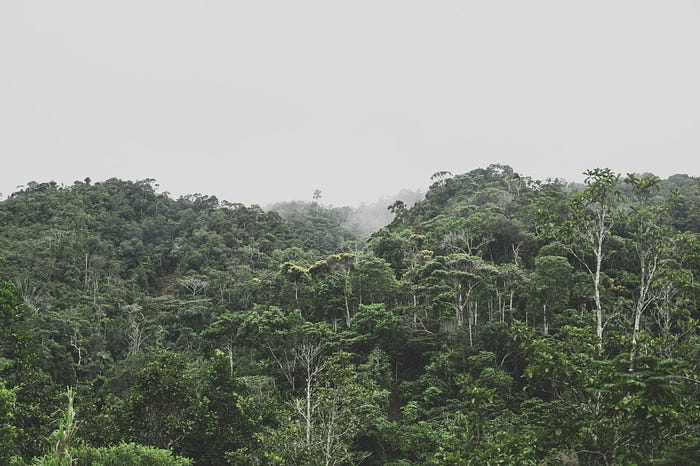
At 6.7 million square kilometers in size — an area about twice the size of India — the Amazon Rainforest accounts for half of the remaining rainforest on Earth. It is the largest swathe of contiguous forest left on the planet, and it is home to more than 10 percent of the world's terrestrial biodiversity: 2.5 million species of insects; 40,000 species of plants; 2,500 species of trees; 1,300 species of birds; hundreds of species of mammals, reptiles, and amphibians. The trees of the Amazon store between 15 and 20 years worth of global carbon dioxide emissions, and the rainforest has a "net cooling effect that helps to stabilize the Earth's climate," to borrow the words of a recent Nature paper, largely thanks to the volumes of water that these trees absorb from the soil and evapotranspire into the atmosphere.
"For 65 million years, Amazonian forests remained relatively resilient to climatic variability," the recent Nature study states. "Now, the region is increasingly exposed to unprecedented stress from warming temperatures, extreme droughts, deforestation and fires, even in central and remote parts of the system."
The Amazon Basin has been warming at an average of 0.27 degrees Celsius per decade since the 1980s. The forest's central and southern regions have been warming even faster, at a rate of 0.6 degrees Celsius per decade. Today, dry season temperatures in the Amazon Basin are, on average, 2 degrees Celsius warmer than they were 40 years ago. The dry season has grown longer, too. "It used to be three to four months," Carlos Nobre, a senior researcher at the Institute for Advanced Studies at the University of Sao Paulo, Brazil, a member of the Intergovernmental Panel on Climate Change (IPCC), and co-author of the recent Nature paper, told me. "Now, it's four to five months."
Droughts in the Amazon Basin have grown more common and severe as a result of climate change, as well. A study published by researchers from the World Weather Attribution (WWA) in January found that the drought that has been afflicting the Amazon Basin since the middle of last year was made 30-times more likely by climate change. This historic drought, the most severe ever recorded in the Amazon, has also been amplified by the El Niño weather phenomenon — a cyclical climate pattern defined by unusually warm temperatures over the central and eastern Pacific Ocean, which typically lasts for 9 to 12 months. During El Niño, trade winds weaken, shifting atmospheric currents away from the Amazon Basin and back toward the west coast of South America. Less rain falls over the Amazon Rainforest as a result.
"Rainfall conditions have also changed," the Nature study states. In the southern Bolivian Amazon, for example, annual rainfall has declined 20 millimeters per year since the 1980s. Data from NASA satellites show that annual rainfall declined 25 percent across two thirds of the Amazon between 2000 and 2012. Rainfall has continued to decline across most of the Amazon Basin in the years since.
For the vast majority of the Amazon's 65 million year history, it was essentially fireproof. The forest was so rich in moisture that its plants and organic debris rarely caught fire. And when they did, they were relatively small, low-intensity burns that provided the rainforest's soil and plants with nutrients. In the Amazon, "there's a biological registry of six thousand years of fire use by Indigenous communities," Dolors Armenteras Pascual, an ecologist at the National University of Colombia who studies wildfires in the Amazon, told me, "and we have never seen these big fires like we see nowadays."
Warming temperatures, dry air, and declining rainfall have made the Amazon Rainforest "more flammable" over recent decades, says Bernardo Flores, a researcher at Brazil's Federal University of Santa Catarina and lead author of the recent Nature paper. A record-breaking 2,940 wildfires burned in the Brazilian Amazon in February of this year, according to data published by Brazil's National Institute for Space Research. Some of them are still burning. All told, more than 10,000 wildfires have burned 11,000 square kilometers of the Amazon Rainforest so far this year, according to data from SERVIR Amazonia, a joint initiative between NASA and USAID that uses remote-sensing satellites to monitor wildfires in the Amazon. Never have this many fires burned so much of the Amazon, so early in the year.
An estimated 17 percent of the Amazon Rainforest has already been deforested, and the bulk of that deforestation has occurred since the turn of the century. As much as 38 percent of what remains of the Amazon Rainforest has been "degraded" by rising temperatures, extreme droughts, declining rainfall, and more frequent and intense wildfires.
"Degradation means that you still have standing forest, but you are losing some of the structure, some of the functioning," says Armenteras Pascual. "You might even look and think it's really a beautiful forest, but it's not so healthy. It was something else before."
One way to think about the degradation of the Amazon Rainforest is in terms of "water stress" — that's the phrase that Flores and his colleagues use in their recent Nature paper time and time again. Hot, dry air saps the Amazon's soil of its moisture. Tree roots struggle to draw water from desiccated earth. Some trees die as a result. Others begin to decline in health, losing their ability to absorb and evapotranspire water and perpetuate the humidity that is characteristic of the Amazon Rainforest. "The Amazon forest itself," the science journalist Daniel Grossman wrote in a feature story for Nature last year, "helps to create the conditions that nourish it."
But the Amazon Rainforest is dying a slow, degradative death as a result of climate change and human-caused habitat destruction. Scientists worry that these trends may soon push the Amazon over the edge.
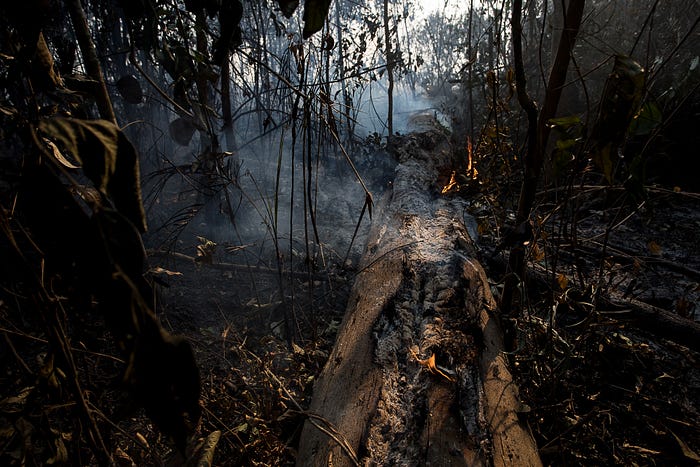
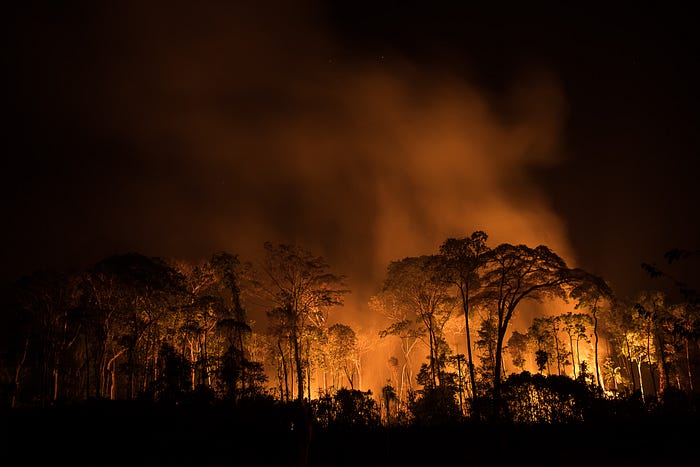
In their recent study, published in Nature on February 14, Bernardo Flores and his colleagues considered the factors contributing to the degradation of the Amazon Rainforest — climate change, drought, low rainfall, deforestation, wildfires, "edge effects" — and developed models projecting these trends into the future. The forecast is gloomy. By 2050, the researchers found, as much as 47 percent of the Amazon Rainforest may reach a "tipping point," at which point much of the Amazon will no longer be a rainforest at all, but a vast swathe of arid savannah and grassland. The Amazon Rainforest, Flores says, may "collapse from megafires and become trapped in a persistently flammable, open-vegetation state." Carlos Nobre calls this "the savannization of the Amazon Rainforest."
Bernardo Flores and his colleagues aren't the first scientists to warn about the Amazon "tipping point." Carlos Nobre has been sounding the alarm on climate change in the Amazon since the 1990s. "I was really the first scientist looking at what deforestation and climate change might do to the Amazon," Nobre told me. If rates of deforestation and global warming were to continue unabated, Nobre discovered, "more than 50 percent of the Amazon forest would become a degraded forest ecosystem. That was in 1991."
Other climate scientists, Nobre continues, "started using the term 'tipping point' twenty years ago," in reference to things like melting permafrost, the collapse of the Greenland and Antarctic ice sheets, the dying of coral reefs. Open up a dictionary and flip to the term "tipping point," and you'll find a definition that reads something like this: "the point at which a series of small changes or incidents becomes significant enough to cause a larger, more important change."
"There are more than 20 tipping points," Nobre says. The Amazon tipping point is one of some two dozen fulcrums in the earth's climate, a fall from which would drastically and irreversibly accelerate climate change, not only in the Amazon but around the globe.
In a 2018 paper published in Science Advances, Nobre and his late colleague, Thomas Lovejoy, applied the term "tipping point" to the collapse of the Amazon Rainforest. The media ran with it, and the term stuck. (Type the words "Amazon tipping point" into a Google search bar, and you'll be greeted with more than 15 million results.) Since then, different studies have defined different "tipping points" for the Amazon Rainforest itself. One study, published in Geophysical Research Letters in 2007, predicted that the Amazon would collapse after 40 percent of the rainforest had been cut down. Another study, published by Carlos Nobre and Luis Salazar (a researcher at Brazil's National Institute for Space Research) in the same journal in 2010, predicted that a tipping point would occur, independent of deforestation, after global atmospheric temperatures rise beyond two to three degrees Celsius.
What these previous studies didn't consider, however, were the "synergies between compounding disturbances that could trigger unexpected ecosystem transitions," in the words of Flores, Nobre, and their colleagues, writing in their new Nature paper. By considering how warming temperatures, more frequent and severe droughts, declining rainfall patterns, more frequent and intense wildfires, and continued deforestation might combine to impact the Amazon Rainforest as a whole, Flores and his colleagues showed that the "Amazon forest system" may reach a tipping point much earlier than scientists previously thought possible.
The paper also showed that some regions of the Amazon are more vulnerable than others — in the near future, at least. The northwestern Amazon, for example — including parts of Colombia, Ecuador, and Peru— is the wettest part of the Amazon Rainforest. As a result, the northwestern Amazon is more resilient to climate change and human disturbances than other, drier parts of the rainforest. This is a region with "low-transition potential," in the words of Flores and his colleagues. That is to say, the northwestern Amazon is unlikely to collapse into a non-forest state anytime soon.
"Northwestern forests rarely experience water stress," Flores and his colleagues write, "which makes them relatively more resilient than southeastern forests."
The central, southern, and eastern Amazon, on the other hand, are drier, and therefore more susceptible to the effects of climate change and other causes of degradation. Flores and his colleagues found that rainfall in the southern and eastern Amazon "will become more seasonal" by 2050. Meanwhile, the dry season across all of the Amazon Basin may grow up to two months longer than dry seasons seen today. As a result, large areas of the central, southern, and eastern Amazon are becoming "bistable," teetering on the edge of a precipice, a fall from which would mean a collapse of vast tracts of rainforest. Nobre and Lovejoy's 2018 study found that, if these more vulnerable regions of the Amazon Rainforest were to lose between 20 and 25 percent of their trees, the "Amazon system" would "flip to non-forest ecosystems."
But the Amazon Rainforest is just that: a system. A collapse of one half of the Amazon forest system would have grave impacts on the half of the Amazon that survives. "It's not like half of the Amazon will collapse and the other half will go on just fine," Armenteras Pascual says. "The whole system might collapse — the whole system in terms of hydrology, which is probably the most important role of the Amazon globally, its role in cooling the climate."

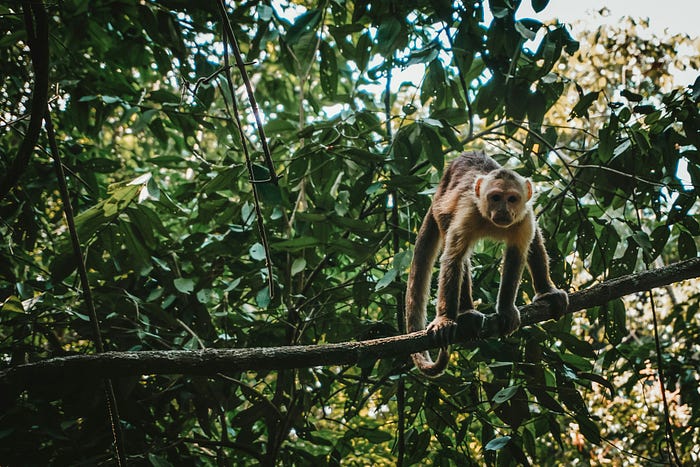
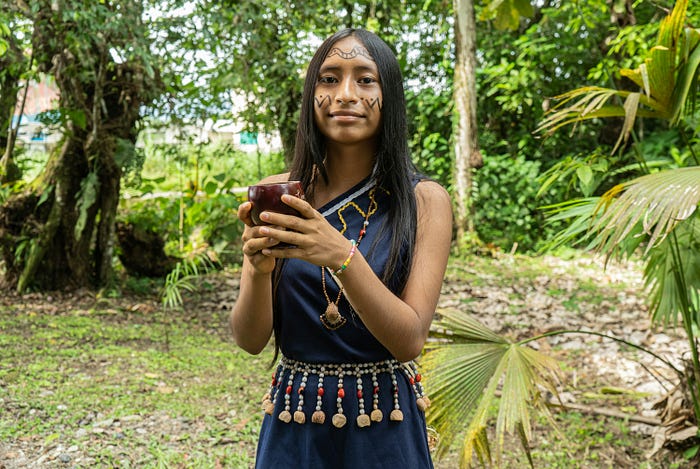
If water is the lifeblood of the planet, the Amazon Rainforest is its heart. The Amazon River, which snakes more than 4,000 miles across the Amazon Basin, pours some 220,000 cubic meters of water into the Atlantic Ocean every second, by far the largest river on earth in terms of the volumes of freshwater that it pours into the ocean. "We have the Amazon," Armenteras Pascual told me, "but we also have the Orinoco River, and the Orinoco is the third largest river in the world in terms of the freshwater that it discharges into the ocean." Combined, the Amazon and Orinoco Rivers account for 25 percent of the freshwater that flows into the planet's oceans.
But the Amazon is home to other rivers as well; rivers in the sky, so to speak. Moisture from the Atlantic Ocean rolls inland off the coast of Brazil, much of which falls as rain over the Brazilian Amazon. The trees of the Amazon, some of which can grow more than 250 feet tall, absorb this rainfall through their roots and evapotranspire this water back into the atmosphere through the stomata on the surface of their leaves. A single mature tree in the Amazon Rainforest recycles 1,000 liters of water per day. "One thousand liters per tree per day," Armenteras Pascual says. This water is cycled and recycled from tree to tree across the rainforest, which flows gradually westward in atmospheric currents that sweep across the Amazon Basin. "These are what we call flying rivers," Carlos Nobre told me.
At times, more water flows in the Amazon's "flying rivers" than in the Amazon River itself. A single water molecule can be recycled eight times — by eight different trees — before reaching the northwestern Amazon, at the foot of the Andes Mountains. The Andes form a kind of natural barrier; the Amazon's flying rivers can't flow up and over the mighty mountain range. The water has nowhere to go, save for the trees. Thus, the trees of the northwestern Amazon recycle about 50 percent of the region's rainfall. In the Brazilian Amazon, that figure is closer to 20 percent. For this reason, the northwestern Amazon is the wettest part of the Amazon Rainforest (and that excess moisture is what makes the northwestern Amazon more resilient to climate change and other causes of degradation than the central, southern, and eastern parts of the rainforest).
All of this moisture creates the humid conditions in which the Amazon and its three million species have evolved, and on which these species have evolved a reliance. The species of the Amazon Rainforest — everything from a bullet ant to a kinkajou to a Harpy eagle to a Demerara Falls tree frog — depend on the moisture that is filtered by the Amazon's trees. So do the 40 million human beings who live in the Amazon Basin, including 2.2 million Indigenous peoples of more than 300 ethnicities.
But the Amazon's flying rivers don't end in the northwestern Amazon. Most of this water eventually makes its way back into the Atlantic Ocean by way of the Amazon and Orinoco Rivers. Some of it rises to form clouds that drift around the globe. Some of it falls as snow in the Andes. Much of it is redirected to the south by the Andes Mountains. "The winds feel the Andes and turn down to the south," Nobre told me. About 45 percent of the water that flows in the Amazon's flying rivers falls as rain in other parts of South America, providing regions that would otherwise be more arid with vital water. "They go all over South America," Nobre said of the Amazon's flying rivers. "Northern Argentina, Brazil, Uruguay, Paraguay, central and eastern Argentina. They go down three to four thousand kilometers."
A collapse of the Brazilian Amazon is particularly worrisome for the Amazon's water cycle, and its flying rivers. The Brazilian Amazon is "where it all starts," says Armenteras Pascual, "with the cycling of the water." If the Brazilian Amazon were to collapse, the trees that absorb rainfall from the Atlantic would largely vanish. The flying rivers that carry this water across the Amazon Basin would dry up, and so would much else of the Amazon Rainforest. If more central regions of the Amazon collapse, the Amazon's flying rivers may be unable to reach the far side of vast tracts devoid of trees. The northwestern Amazon would begin to dry up as a result.
The very moisture that, at present, makes the northwestern Amazon more resilient to climate change and degradation may make the region more vulnerable to large-scale climatic changes in the long run. "As a result of low exposure to water deficit," Flores and his colleagues write, "most northwestern forests have trees with low drought resistance and could suffer massive mortality if suddenly exposed to severe water stress." The trees of the northwestern Amazon have rarely experienced a drought. Therefore, they haven't evolved to adapt to such dry and arid conditions. If the eastern and central regions of the Amazon Rainforest collapse, that may very well change, and scientists aren't sure that the trees of the northwestern Amazon would survive such a dramatic change of climate.
"Up to one-third of the total annual rainfall in Amazonian territories of Bolivia, Peru, Colombia and Ecuador depends on water originating from Brazil's portion of the Amazon forest," Flores and his team write. "This international connectivity illustrates how policies related to deforestation, especially in the Brazilian Amazon, will affect the climate in other countries."
"It's a whole system," Armenteras Pascual says of the Amazon Rainforest. "The moisture cycle is what collapses. That's what we mean when we talk about the 'tipping point'. Everything will collapse."
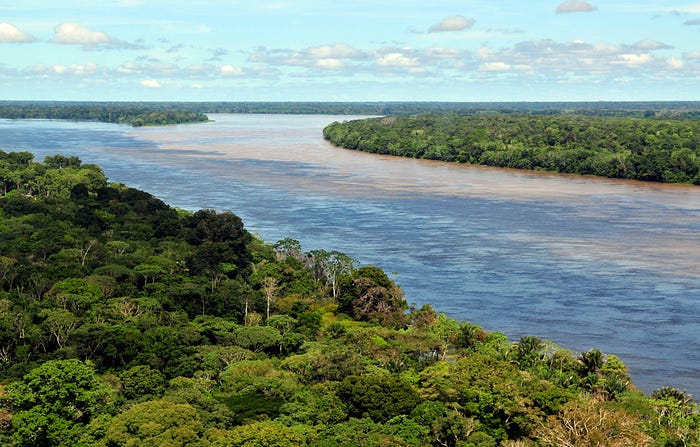

Earlier this month, Nobre and his colleagues published a paper in Scientific Reports unpacking what a post-tipping point future would look like in the Amazon Rainforest, and what it would mean for the climate of much else of South America. "This paper was different from the Nature paper," Nobre told me. "The Nature paper looked at how close we are to the tipping point. This paper took it for granted. Let's assume we cross the tipping point. What's going to happen to the climate of the Amazon? What's going to happen to the climate outside of the Amazon?"
The results are just as drastic and important as those of the recent Nature paper, but they've received little attention in the media. If the Amazon reaches a tipping point, Nobre and his colleagues found, the Amazon's flying rivers will decline to a trickle of their former selves. "Annual rainfall over large tracts of South America," the study states — including parts of Argentina, Brazil, Paraguay, and Uruguay — may decline 44 percent. The dry season across the Amazon Basin and other parts of South America may grow two months longer than the dry seasons of today. "Heat waves," Nobre said, "we will have much, much worse heat waves. The temperature will increase." Temperatures over the Amazon Basin, Nobre and his team's models show, may grow 14 degrees Celsius warmer than they are today due to the "combined effects of savannization and global warming."
"These will be the consequences of losing the Amazon," Nobre told me.
For more than 65 million years, the species of the Amazon Rainforest have evolved with the abundance of moisture that the rainforest itself sustains. Plants reliant on this water, such as Brazil nut trees (Bertholletia excelsa) and Angelim vermelho, the tallest trees in the Amazon, may die off and be replaced by more fire-tolerant and drought-resistant species, like palm trees. This trend can already be seen in parts of the Amazon hard-hit by climate change, deforestation, drought, and wildfire. In degraded regions of the Amazon, palm trees, invasive grasses, and ferns now grow where pristine forests once stood — all of which are much more flammable than the intact and humid rainforest. A 2021 report from the Science Panel for the Amazon found that 10,000 of the rainforest's plant and animal species are at risk of extinction due to climate change and habitat destruction. Crossing the tipping point may very well push these species over the edge.
Human beings will be impacted as well. Many of the Amazon's 40 million human inhabitants may be displaced by "potentially unbearable heat," in the words of Flores and his colleagues. Indigenous peoples and local communities, the researchers continue, "would be harmed by forest loss in terms of their livelihoods, lifeways and knowledge systems that inspire societies globally."
Rainfall patterns would change, not only in the Amazon Basin but across much else of South America. "Without the flying rivers," a Brazilian climate scientist and member of the IPCC named Antonio Nobre (Carlos Nobre's brother) warned back in 2009, southern Brazil, which produces nearly 70 percent of South America's GNP, "would be desert." A study published in Scientific Reports in 2017 found that, if 30 to 50 percent of the Amazon Rainforest were to be deforested or collapse into a non-forest ecosystem — as Flores and his team's models show, may occur by 2050 — rainfall in the northwestern Amazon and "vast parts of South America" would decline by 40 percent. Water from the Amazon's flying rivers is South America's "most important moisture source," the study states. Without it, rivers and wetlands may dry up, hundreds of miles away from the Amazon Basin, leaving millions of people without water to drink and irrigate their crops.
If the Amazon Rainforest were to collapse, a study published in Nature Communications in 2021 found, southern Brazil's agricultural industry would lose up to $1 billion per year. Brazil is the world's largest exporter of soybeans (much of which is grown on farmland where rainforest once stood), accounting for about 34 percent of the planet's soybean supply. If Brazil's agricultural industry were to see such drastic declines, the livelihoods of millions of people would be affected. The world may see food shortages, not only shortages in soybeans, but in crops like rice, cocoa, cotton, and corn as well.
"Destroying the Amazon to advance the agricultural frontier is like shooting yourself in the foot," Antonio Nobre said in a 2014 interview with Valor Economica. "The Amazon is a gigantic hydrological pump that brings the humidity of the Atlantic Ocean into the continent and guarantees the irrigation of the region."
It's ironic, then, that Brazil's agricultural industry would be particularly hard hit by a collapse of the Amazon Rainforest, as agriculture is the primary driver of deforestation and degradation in the Brazilian Amazon. "Of course, we need agriculture," Antonio Nobre continues. "But without trees there would be no water, and without water there is no food."
"When a forest reaches a tipping point," Bernardo Flores told me, "it becomes much more difficult, if not impossible, to control the variables that cause it to transition. When this happens at larger scales, these transitions begin to affect the regional climatic conditions and could potentially make some parts of the Amazon uninhabitable due to unbearable aridity. This would also affect rainfall patterns, reducing moisture flow across the South American continent and even to other continents. The Amazon forest is a major pump of moisture into the atmosphere, contributing to circulation processes that transfer moisture across the globe. When the forest is reduced, this weakens this process, causing the global climate to find a new equilibrium."
A 2013 study published in the Journal of Climate found that a collapse of the Amazon Rainforest would result in 20 percent less rain falling over the United States' Pacific Northwest and 50 percent less snow falling in California's Sierra Nevada each year. "If we lose the forest," Carlos Nobre told me, "we may have global impacts: in Asia, North America, and also in Antarctica."
The cascading effects of the Amazon tipping point extend beyond the Amazon Basin in other ways as well. Combined, the Amazon and Orinoco Rivers pour more than 300,000 cubic meters of freshwater into the Atlantic Ocean every second. If the rainforest collapses and the Amazon's flying rivers dry up, so too will these major river systems, resulting in less freshwater flowing into the ocean, along with less sediment and nutrients for the Atlantic's marine ecosystems; and less carbon being stored in the planet's deep ocean carbon pool.
All of this said, studies investigating how, exactly, a collapse of the Amazon Rainforest would impact the world's oceans and the global water cycle remain sparse in the scientific literature. "It will affect the global system," says Armenteras Pascual. "I'm not sure we've been able to communicate the urgency of this issue." That goes for scientists and journalists alike, she added.
"These are important questions," Nobre said of the Amazon tipping point's effects on the world's oceans. "We don't know much about that, but this is really something that's worthy of more investigation."
And all of this is to say nothing of carbon emissions. The Amazon Rainforest's 390 billion trees store between 15 and 20 years worth of global CO2 emissions. For this reason, the Amazon is sometimes called "the lungs of the planet." If the Amazon were to undergo a "large-scale collapse" by 2050, as Flores and his colleagues warn, it may emit as much as 120 billion tons of carbon dioxide into the atmosphere. Global temperatures may rise 0.3 degrees Celsius as a result. If this were to occur, it would "make it much more difficult for humanity to keep greenhouse gas concentrations at a safe level," Flores told me.
This brings me to another definition of the Amazon tipping point. Some researchers argue that the Amazon "tipping point" will occur when the forest begins emitting more carbon into the atmosphere than it is able to store in the bark of its trees. Other scientists argue that this is more of an effect than a cause; a symptom of the rainforest fast approaching its tipping point. In any case, evidence is mounting to suggest that this has already begun to occur in some parts of the rainforest. In 2021, a team headed by Luciana Gatti, a climate scientist at Brazil's National Institute for Space Research, found that the southeastern Amazon is no longer a carbon sink, but a carbon source. Between 2010 and 2018, Gatti and her team found, the southeastern Amazon emitted about 1.5 billion tons of carbon dioxide due to a combination of wildfires and deforestation. The region stored half a billion tons of CO2 over the same period. The study also found that the forest's carbon sink — the trees' ability to store carbon dioxide — has weakened across most of the Brazilian Amazon.
The Amazon Rainforest, once one of the planet's largest carbon sinks, teeters on the edge of becoming a major carbon source.
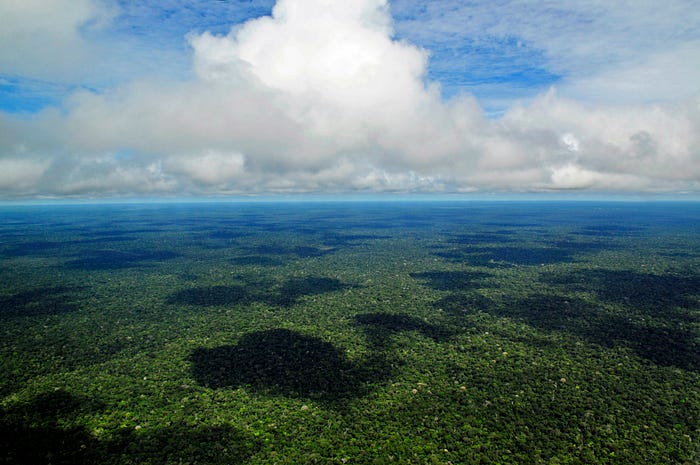
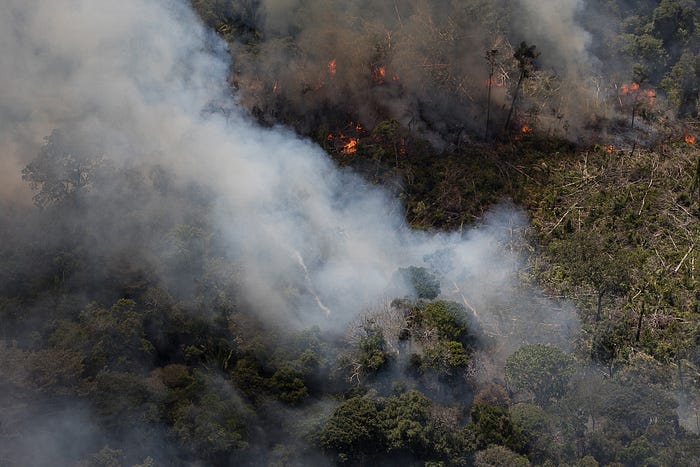

The Amazon Rainforest, Dolors Armenteras Pascual told me via a Zoom chat, is a system, but it dies one tree at a time. "If you remove one tree, or one tree dies from drought, that's 1,000 liters of water less for the whole system. So you can imagine, if you remove a hundred trees, a thousand trees, a billion trees…" She shook her head.
"We are very close to the tipping point," Carlos Nobre, who was awarded a Nobel Peace Prize in 2007 for his work with the IPCC, told me. "But last year, we had good news: a 50 percent reduction in deforestation all over the Amazon. And in January and February of this year, a continued reduction in deforestation." This trend gives Nobre hope for the future of the Amazon Rainforest. "I'm very optimistic," he said.
Late last year, at the United Nations COP28 climate summit in Dubai, Brazil's national development bank (BNDES) announced the Arc of Restoration program — an $205 million initiative to restore 60,000 square kilometers of the Amazon Rainforest by 2030. Researchers estimate that the project would capture about 1.65 billion tons of CO2 from the planet's atmosphere by the end of the decade. Carlos Nobre sees the Arc of Restoration program as a step in the right direction, but he has even higher hopes for the future of the rainforest. "We need to do a very large-scale restoration," Nobre told me. "We need to get to zero deforestation, zero degradation."
"We have almost two million square kilometers of forest degraded," Nobre continues. "So, let's say that we stop deforestation and degradation, and then, between now and 2050, we restore one million square kilometers, 50 percent of this area. Then we might avoid the tipping point if global warming does not exceed 1.5 degrees."
"I'm not saying this is going to be easy," Nobre added, "but I'm optimistic that this is possible. I'm optimistic that we — the Amazonian countries — will do our part to end the destruction of the Amazon. What I'm not optimistic about is global warming."
Limiting global warming to 1.5 degrees, Nobre says, would require a 50 percent reduction in global CO2 emissions by 2030 and net zero emissions by 2050. Meanwhile, global CO2 emissions continue to increase every year (with the exception of a slight decline in emissions in 2020, thanks to the coronavirus pandemic). Global temperatures in January of this year were 1.6 degrees Celsius warmer than pre-industrial temperatures, and scientists are predicting that the remainder of 2024 may be just as warm, if not warmer. Earlier this year, researchers from the U.S. National Oceanic and Atmospheric Administration (NOAA) said that 2024 has a one-in-three chance of being hotter than 2023, and a 99 percent chance of ranking among the top five warmest years in recorded history.
"We are not moving in the right direction," Nobre says. "That's my concern."
To save the Amazon, Flores, Nobre, and their colleagues say that both local and global efforts are needed. A passage from their Nature paper reads: "Keeping the Amazon forest resilient in the Anthropocene will depend on a combination of local efforts to end deforestation and degradation and to expand restoration, with global efforts to stop greenhouse gas emissions."
"At the local scale," the paper continues, "two practical and effective actions need to be addressed to reinforce forest-rainfall feedbacks that are crucial for the resilience of the Amazon forest: (1) ending deforestation and forest degradation; and (2) promoting forest restoration in degraded areas. Expanding protected areas and Indigenous territories can largely contribute to these actions."
Indigenous territories in the Amazon Rainforest appear to be more resilient than those that have been more thoroughly degraded by climate change and habitat destruction. Indigenous territories have some of the lowest fire regimes in all the Amazon Basin. These territories are warming at a much slower rate than regions that have been hard-hit by deforestation and degradation; some are actually cooling, despite warming global temperatures. They are also, on average, some of the wettest parts of the Amazon Rainforest.
Ancient sedimentary layers show that Indigenous peoples have been using fire in the Amazon Basin for at least six thousand years, in a way that has had a minimal impact on the health of the rainforest. "They plant their crops for one year or two years," says Armenteras Pascual, "but they don't keep doing the same thing. They let the forest recover and move to another place, and that's why they live in such an extended territory, because they are rotating the use of the forest in a way that they are letting the forest recover."
"Indigenous people have a lower population density living in the region," she continues, "but they also let the land rest. It's sustainable. That's the key point. And it has been for centuries." Perhaps we could learn a thing or two from these Indigenous cultures, who have coexisted with the ecosystems of our planet, sustainably, for millennia.
Like Nobre, Dolors Armenteras Pascual still has hope for the future of the Amazon Rainforest. "These forests are amazing in terms of their regenerative capacity, if you let them," she told me. "But if you burn too much, there's a limitation. If you keep burning, it's never going to recover."
Simply put, we need to "let the land rest," Armenteras Pascual said.
We live at a crucial juncture in the history of our planet. Our actions today and over coming years and decades will determine our planet's future, and the future of all life on earth. We are the first generation of human beings to see what we are doing to the planet with clarity. With that clarity comes a certain kind of grief, a grieving for the death of the natural world as it once existed; and a certain kind of optimism, the knowledge of what we can do to save the Amazon and the planet at large, and the hope that we are wise enough to act accordingly.
Note: Portions of this article draw from a few stories I've written for other publications recently, including this piece in WIRED and this one in Live Science. While reporting these other, shorter pieces, I developed a lot of material, far too much to include in the stories I set out to write. This story is the culmination of everything I've learned about the Amazon tipping point over the last few weeks. There's plenty more to come on this topic in the near future. For now, thanks for reading.

